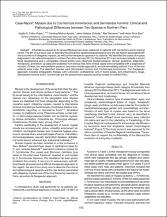Case Report: Myiasis due to Cochliomyia hominivorax and Dermatobia hominis: Clinical and Pathological Differences between Two Species in Northern Peru

Ver/
Trabajo
(application/pdf: 463.9Kb)
(application/pdf: 463.9Kb)
Fecha
2018-01-10Autor(es)
Failoc-Rojas, Virgilio E.
Molina-Ayasta, Carolina
Salazar-Zuloeta, Jaime
Samamé, Abel
Silva-Díaz, Heber
Metadatos
Mostrar el registro completo del ítemResumen
Infestations caused by fly larvae (Myiasis) have been observed in patients with risk factors and in tropical zones. The aim of our study was to describe the clinical and epidemiological aspects and the risk factors associated with the occurrence of obligatory myiasis, as well as the therapeutic approach to patients. We identified the cases of myiasis diagnosed in two referral hospitals in northern Peru from January 2012 to December 2015 and included patients in whom larval development and a compatible clinical profile were observed. Epidemiological, clinical, analytical, diagnostic, therapeutic, and follow-up data were collected from clinical files. Nine clinical cases were compatible with a diagnosis of myiasis; of these, two were pediatric patients, one was a middle-aged adult, and six were elderly patients. Four of the nine patients were male. The identified species were Dermatobia hominis and Cochliomyia hominivorax. The therapeutic approach included antiparasitic therapy with ivermectin, antibacterial, and in some cases, anti-inflammatory drugs. Dermatobia hominis and C. hominivorax are the predominant species causing myiasis in northern Peru.
Colecciones
- Artículos [274]
Editor
American Society of Tropical Medicine and Hygiene
Acceso
info:eu-repo/semantics/openAccess
Recurso(s) relacionado(s)
https://doi.org/10.4269/ajtmh.16-0437http://repositorio.upch.edu.pe/handle/upch/4282







